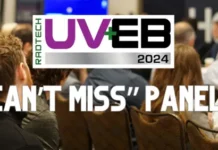By Dianna Brodine, managing editor, UV+EB Technology
Brand owners and consumers care about packaging. Whether it’s plastic pop rings or understuffed cardboard boxes from online retailers, consumers are taking note – and calling out brand owners for their lack of environmental awareness. As this affects the bottom line, brand owners are in turn putting pressure on their supply chain to create packaging that does not place a burden on the waste stream – and inks and coatings aren’t exempt. Energy-cure technologies are stepping forward to showcase their sustainability and recyclability advantages.
Repulpability of energy-cured paper and board
In 1992, RadTech International North America commissioned a study with The Beloit Corporation “to perform a series of pilot deinking trials performed on printed and coated paper containing a variety of ink and coating combinations. Included in the evaluation of the more widely used ‘conventional’ ink systems were ultraviolet (UV)- and electron beam (EB)-cured inks and coatings. The objective of these trials was to determine the behavior of the various ink and coating combinations in terms of repulpability and deinkability.”1
The study results showed UV- and EB-cured inks and coatings did not affect the repulpability of the samples tested, that all samples in the study could be recycled into low-quality board grades, and that “UV- and EB-printed and coated paper can be recycled into tissue and/or fine paper grades using commercially available equipment.”1
To this day, the RadTech/Beloit study continues to be referenced. In fact, the European Printing Ink Association (EuPIA) European Technical Committee mentioned the study in its April 2021 statement on the recyclability of UV-printed paper and board packaging2, along with confirmations from the American Forest and Paper Association3 and others. The EuPIA statement concluded, “UV-printed paper-based materials are recyclable, and printing ink manufacturers continue to invest resources to further improve the deinkability performance of UV inks and minimize their impact on current paper and board recycling procedures.”
In addition, UV-, EB- and UV LED-curable inks and coatings offer sustainability benefits before the product reaches the recycling stage. Two ink manufacturers shared their perspective on what benefits energy-cured inks and coatings are contributing to the conversation.
Solvents and VOCs
“Across the globe, the industry is aiming to reduce carbon emissions and volatile organic compounds (VOCs),” said Jim Bishop, field product manager, UV, EB & Conventional Packaging Products, Sun Chemical. “Brand owners and converter partners worldwide are aiming to emit little-to-no VOCs in their processes, because when a printer offers low VOC, it significantly reduces the carbon footprint of a business. Energy-curable ink chemistries are beginning to include bio-renewable and recycled raw materials, based on modified resin developments and also on available post-consumer recycled plastics. Energy-curable inks are considered zero VOC or 100% solids, thus diminishing the discussion around emissions.”
Fabien Koehn, Global Head of NW Product Management, Siegwerk, contributed to the conversation on solvents and VOCs. “UV/LED inks do not contain any solvent, and the entire wet ink applied will stay on the printed substrate,” he said. “China is currently enforcing the regulation regarding VOCs, and UV/LED ink is one of the solutions offered to stay within their regulations. Furthermore, using no solvent has a benefit as there is no need to transport the solvent as part of the ink from supplier to customer, thus reducing the carbon footprint for transportation.”
Carbon footprint – typically expressed as total greenhouse gas emissions – also was pointed to by Derrick Hemmings, product manager, EC Flexo & LED NA & ECP Canada, Sun Chemical, with acknowledgement that a discussion of carbon footprint advantages requires more than an assessment of emissions. “The potential environmental/sustainability advantages provided by UV or EB inks and coatings is a complex subject, which to address properly requires a full life cycle analysis versus each system for which such advantages are being claimed. While UV/EB inks do not generate VOC’s during the printing process, carbon dioxide is generated during the upstream raw material manufacturing processes and must be accounted for to make a valid comparison.”
Energy consumption
Equipment manufacturers are enabling further sustainable advantages to energy-curable inks and coatings with developments in UV LED technology.
“Converters are seeing further environmental and application benefits of UV LED cured technology as it offers the largest volume and growth opportunities due to the high productivity and performance advantages it has,” said Hemmings. “From an energy standpoint, UV LED consumes less electricity and eliminates ozone production during printing, which is important to many users who are considering LED as an option.”
Koehn added, “Compared to standard Hg-Arc UV lamps, LED-UV lamps consume only a fraction of the energy due to the efficiency of LED-UV lamps and the instantaneous on-off behavior … means only energy consumption when needed. Even larger is the advantage compared to the energy consumption for thermal drying of water-based or solvent-based inks.”
What about plastic?
Print and packaging applications aren’t limited only to paper or paperboard substrates. Plastics protect the product inside from contamination during manufacturing, transport or display; preserve food, cosmetics and medical applications; and reduce waste. Yet, plastics can cause problems for inks and coatings when viewed under the lens of sustainable use.
“UV-cured inks do present some unique challenges for in-mold labeling,” said Bishop. “For example, UV lamps generate significant heat of approximately 1,600mW/cm2 and 74mJ/cm2. When improperly used or balanced, UV lamps can cause distortion or warping in the films and the inks. Lamps that are too hot can cause films to become brittle or curl – two factors that can create significant problems in an injection molding machine.” Any distortion that occurs during molding could cause the molded product to fail quality standards, creating additional waste. He continued, “Under-cured inks can cause ink washout or poor slip. Sun Chemical offers a variety of inks to overcome these challenges.”
In addition to some production complications, the deinking of plastic substrates isn’t always straightforward in the recycling process. “As the need grows for recycled plastic in the industry, there will also be an increased need for recycled plastic packaging and eventually plastic labels, said Koehn. “Siegwerk has developed washable ink solutions that allow recycling of particular shrink sleeve labels. The UV/LED inks will deink entirely from the sleeve substrate, rendering a clean film that can be recycled. In this process, UV/LED inks have an advantage over other ink technologies: Large particles will flake off from the substrate, allowing the recycler to easily filter the ink particles out of the wash water.”
Growth in food packaging applications
Opportunities for expanded use of UV- and EB-curable chemistries exist in a variety of areas, but flexible packaging – particularly for food applications – may lead the pack. The flexible packaging industry is set for growth, according to a recent report from Smithers.3 “Smithers forecasts that demand will return through 2021 as lockdown (shelter-in-place) orders are lifted and international trade flows resume. Flexible packaging will benefit directly from this, and Smithers forecasts a compound annual growth rate (CAGR) of 3.4%, by volume. This will see total consumption reach 37.5 million tonnes in 2026.” Much of this growth will be in food packaging – already at 75% of total flexible packaging demand, according to the report.
Hansruedi Nef, product manager BU Narrow Web EMEA at Siegwerk, said, “The combination of LED curing and low-migration inks is a truly sustainable approach that we promote for food packaging applications. It is combining the efficiency of LED technology and its strength to ensure reliable curing over a long period of time with inks optimized for migration so that the printed food packaging is safe.”
Bishop agreed, while also noting benefits of mercury lamp technology. “We’re seeing strong use of UV- and EB-cured inks and coatings in the packaging market, specifically food packaging,” he said. “When using low-migration capable inks in food packaging, a mercury lamp can facilitate a more complete cure of the ink, so there is less possibility of migration. And, consumers are beginning to consider moving from lamination applications and pursuing interests in EB offset and EB flexo curing for flexible packaging applications.”
Thank you to Siegwerk and Sun Chemical for their contributions to this article. Additional interview content can be accessed at www.uvebtechnology.com. Worldwide, Siegwerk can offer a comprehensive portfolio for LED-UV curing, for standard flexo, screen and offset and flexo applications as well as for FCM (Food Compliant Material) applications (low migration inks). For more information, visit www.siegwerk.com. Sun Chemical, a member of the DIC Group, is a leading producer of packaging and graphic solutions, color and display technologies, functional products, electronic materials, and products for the automotive and healthcare industries. For more information, visit www.sunchemical.com.
References
- “Recyclability of UV and EB Printed and Coated Paper,” RadTech Report, May/June 2005, www.radtech.org
- “Recyclability of UV Product Printed Paper and Board Packaging,” April 23, 2021, www.eupia.org
- “Design Guidance for Recyclability of Paper-Based Packaging,” www.afandpa.org
- “The Future of Global Flexible Packaging to 2026,” Smithers, February 2021, www.smithers.com






